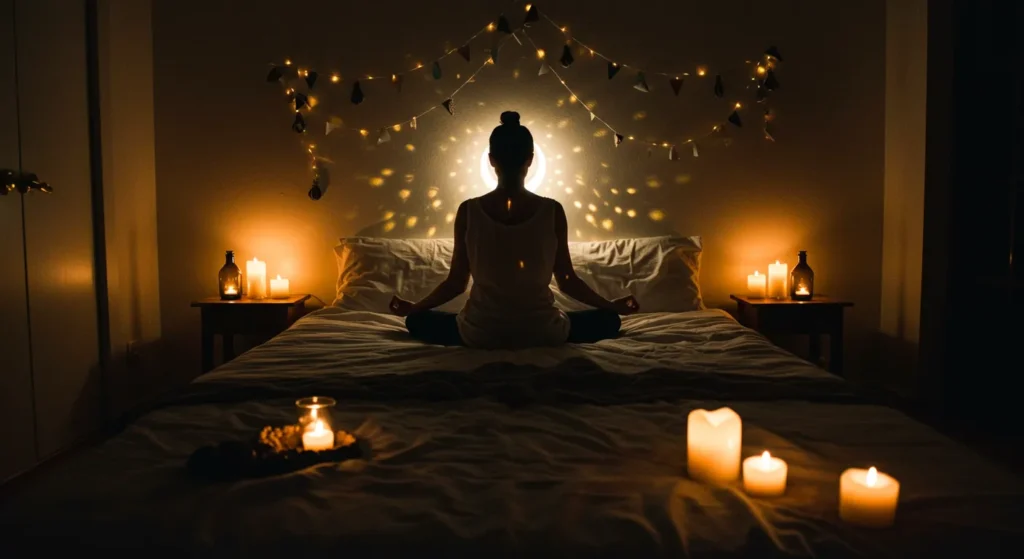Sleep Meditation Techniques: 5 Science-Based Methods That Actually Work in Under 15 Minutes

It was 3:17 AM when Federico finally gave up counting sheep and tried something different. Instead of fighting his racing thoughts, he decided to work with them.
That night changed everything. What started as desperate experimentation became a sleep meditation technique that now helps thousands of people fall asleep faster and sleep more deeply.
If you’re tired of lying awake while your mind replays every conversation from the day, you’re in the right place. Sleep meditation techniques aren’t just trendy wellness advice – they’re scientifically proven methods that can transform your nights in as little as 10-15 minutes.
We’ll share the exact meditation for better sleep practices that have worked for our community, backed by research from sleep labs and neuroscience studies. No mystical mumbo-jumbo, just practical techniques you can start using tonight.
Key Takeaways
✓ Sleep meditation reduces the time to fall asleep by up to 50% according to clinical studies
✓ Just 10 minutes of practice can improve sleep quality and reduce morning grogginess
✓ These techniques work anywhere – your bed, a hotel room, or even a noisy environment
✓ No special equipment needed – your breath and awareness are the only tools required
✓ Results improve with consistency – even beginners notice changes within the first week
The Science Behind Sleep Meditation (Why Your Brain Loves It)
Here’s what’s fascinating: when you practice sleep meditation techniques, you’re literally rewiring your brain’s response to bedtime.
Research from Johns Hopkins shows that meditation for better sleep activates your parasympathetic nervous system – the “rest and digest” mode that prepares your body for sleep. Your heart rate slows, blood pressure drops, and stress hormones like cortisol naturally decrease.
But here’s the part that really caught our attention: brain imaging studies reveal that people who practice deep sleep meditation techniques show increased activity in areas associated with attention regulation and decreased activity in regions linked to worry and rumination.
Think of it this way – instead of your brain being like a busy highway at rush hour, sleep meditation creates the mental equivalent of a peaceful country road at sunset.
Busting the Biggest Sleep Meditation Myths
Myth 1: “You need to empty your mind completely” Reality: The goal isn’t to stop thinking – it’s to change your relationship with thoughts. Sleep meditation techniques teach you to observe thoughts without getting caught up in them.
Myth 2: “It takes months to see results” Reality: Many people experience better sleep within the first few nights of practicing meditation for better sleep. Consistency matters more than perfection.
Myth 3: “You have to sit in lotus position” Reality: The best sleep meditation happens lying down in your bed. Comfort is key, not complicated postures.
5 Powerful Sleep Meditation Techniques That Actually Work
1. The 4-7-8 Breathing Technique – The Natural Sedative
This breathing meditation for sleep is like nature’s tranquilizer. Dr. Andrew Weil calls it “a natural sedative for the nervous system.”
How to practice:
- Lie comfortably in bed
- Exhale completely through your mouth
- Close your mouth, inhale through your nose for 4 counts
- Hold your breath for 7 counts
- Exhale through your mouth for 8 counts
- Repeat 3-4 cycles
Why it works: This technique activates your vagus nerve and forces your heart rate to slow down. The longer exhale triggers your relaxation response faster than almost any other sleep meditation technique.
Pro tip: Don’t worry about perfect counting. The rhythm matters more than precise timing.
2. Progressive Muscle Relaxation – The Tension Release Method
This guided muscle relaxation for sleep technique literally teaches your body what deep relaxation feels like.
The process:
- Start with your toes – tense them for 5 seconds, then release
- Move to your calves – squeeze, hold, release
- Continue up your body: thighs, glutes, abdomen, hands, arms, shoulders, face
- End by tensing your whole body for 5 seconds, then letting everything go
- Notice the contrast between tension and relaxation
The science: When you consciously tense and release muscles, you’re teaching your nervous system to recognize and create the feeling of complete relaxation. It’s like giving your body a roadmap to sleepiness.
Many people find this relaxation exercise for sleep so effective that they fall asleep before completing the full body scan.
3. Guided Imagery for Sleep – The Mental Vacation
Guided imagery for sleep works by giving your mind something peaceful to focus on instead of tomorrow’s worries.
Create your sleep sanctuary:
- Picture a place where you feel completely safe and calm
- Engage all your senses: What do you see? Hear? Smell?
- Maybe it’s a quiet beach with gentle waves
- Or a cozy cabin with a warm fireplace
- A peaceful forest with soft sunlight filtering through trees
Make it real: The key is detail. The more vividly you can imagine your peaceful place, the more your body responds as if you’re actually there.
This sleep meditation technique works because your brain has trouble distinguishing between vividly imagined experiences and real ones. When you mentally visit a calm place, your body follows suit.
4. The Body Scan Meditation – The Awareness Reset
This deep sleep meditation technique turns your attention inward and away from racing thoughts.
Step by step:
- Start at the top of your head
- Slowly move your attention down through your body
- Notice each part without trying to change anything
- Head, neck, shoulders, arms, chest, abdomen, hips, legs, feet
- If you notice tension, just acknowledge it with curiosity
- Let your attention be like a gentle spotlight moving through your body
Why it’s powerful: The body scan interrupts the cycle of anxious thinking by redirecting your attention to physical sensations. It’s nearly impossible to worry about tomorrow’s presentation when you’re focused on the feeling of your left pinky toe.
5. Counting Meditation – The Mind Anchor
Sometimes the simplest sleep meditation techniques are the most effective. This isn’t your grandmother’s sheep counting – it’s a focused awareness practice.
The method:
- Count backwards from 100, one number per exhale
- If your mind wanders, gently return to counting
- Don’t worry about where you lost track – just start again
- Most people never make it past 50
Advanced version: Count backwards from 300 by threes (300, 297, 294…). This requires just enough mental engagement to prevent mind-wandering without being stimulating.
The beauty: This technique gives your mind a simple, repetitive task that naturally leads to drowsiness. It’s like mental white noise that drowns out worried thoughts.
Creating Your Personal Sleep Meditation Routine
The best sleep meditation practice is the one you’ll actually do consistently. Here’s how to build yours:
Start small: Choose one technique and practice for just 5-10 minutes nightly. Consistency beats duration every time.
Set the stage: Dim lights 30 minutes before bed, put devices away, and create a calm environment that supports your meditation for better sleep.
Be patient with yourself: Some nights your mind will be quieter than others. That’s normal. The practice works even when it feels like it’s not working.
Experiment: Try different sleep meditation techniques to find what resonates with you. Your ideal practice might combine elements from several methods.
Track your results: Notice changes in how quickly you fall asleep, sleep quality, and how you feel in the morning. This reinforces the habit and shows you what’s working.
When to Use Different Sleep Meditation Techniques
For racing thoughts: Try counting meditation or guided imagery For physical tension: Progressive muscle relaxation is your friend
For anxiety: The 4-7-8 breathing technique works wonders For general restlessness: Body scan meditation creates full-body awareness For travel or noisy environments: Breathing meditation for sleep works anywhere
Remember, these relaxation exercises for sleep are tools in your toolkit. Different nights might call for different approaches.
Combining Meditation with Sleep Hygiene
Sleep meditation techniques work even better when combined with good sleep hygiene:
- Keep your bedroom cool (65-68°F) and dark
- Practice your meditation for better sleep at the same time each night
- Avoid caffeine after 2 PM and large meals before bed
- Use comfortable, breathable bedding
- Consider natural sleep aids like magnesium or chamomile tea
Think of sleep meditation as the cornerstone of your bedtime routine, not the entire structure.
Troubleshooting Common Sleep Meditation Challenges
“My mind keeps wandering” This is normal! The goal isn’t to stop thoughts but to notice when your mind wanders and gently return to your sleep meditation technique. Each time you notice wandering and come back, you’re strengthening your awareness muscle.
“I feel more awake after meditating” You might be trying too hard. Deep sleep meditation techniques should feel effortless. If you’re working to meditate, try switching to a simpler technique like counting or breathing.
“Nothing seems to work” Give each technique at least a week of consistent practice before switching. Your nervous system needs time to learn new patterns. Also, consider whether stress, caffeine, or other factors might be interfering.
Frequently Asked Questions About Sleep Meditation
Q: How long should I practice sleep meditation? A: Start with 10-15 minutes. Even 5 minutes of breathing meditation for sleep can be effective. Quality and consistency matter more than duration.
Q: What if I fall asleep during meditation? A: That’s actually the goal! Sleep meditation techniques are designed to guide you naturally into sleep. Don’t fight it.
Q: Can I use apps for guided sleep meditation? A: Absolutely. Apps can provide structure and guidance, especially when learning guided imagery for sleep or progressive relaxation for sleep. Just avoid screen light by using audio-only features.
Q: Is sleep meditation safe for everyone? A: Sleep meditation techniques are generally safe for most people. However, if you have a history of trauma or anxiety disorders, consider working with a qualified instructor initially.
Q: When should I practice if I’m a shift worker? A: Practice meditation for better sleep 30-60 minutes before whatever time you need to sleep, regardless of the hour. Your body will learn to associate the practice with sleep preparation.
Your Journey to Better Sleep Starts Tonight
Here’s what we’ve learned after helping thousands of people improve their sleep: the most powerful sleep meditation technique is the one you’ll use consistently.
You don’t need to master all five methods we’ve shared. Pick one that resonates with you and commit to practicing it for at least a week. Notice what changes. Adjust as needed. Build from there.
Sleep meditation isn’t about becoming a meditation expert – it’s about reclaiming your nights and waking up refreshed. It’s about having a reliable tool when your mind is spinning and sleep feels impossible.
Your well-rested future self is waiting. The only question is: which technique will you try first tonight?
Ready to dive deeper into science-backed wellness strategies? Explore our complete guide to optimizing your circadian rhythm and discover more practical biohacking techniques for better energy and focus. If optimizing your sleep health is a priority, then our Ultimate Guide to Deep Sleep is an essential read to understand this foundational element.
Disclaimer: The information provided is for educational purposes only, not a substitute for professional medical advice. Always consult a healthcare professional.







